
Ellen Balkin is the Education Manager and Suzanna Ritz is the Curriculum Coordinator for the Ogden Museum of Southern Art.
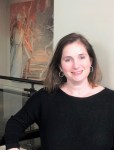
By all accounts, the educational landscape of New Orleans has changed dramatically since Hurricane Katrina. The city “essentially erased its traditional school district and started over,” wrote Doug Harris, director of the Education Research Alliance for New Orleans. The Orleans Parish School Board lost almost all its authority, laying off most teachers, and the State created a special Louisiana Recovery School District which converted most of the schools into semi-independent charters run by nonprofit boards. In turn, these nonprofits depended heavily on alternative-certification programs like Teach for America for staffing. For further reading on this subject, check out New Orleans Public Schools History from Tulane’s Cowen Institute for Public Education Initiatives.
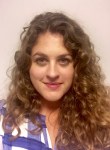
As a result of the decentralization of our district, the use of alternative staffing, and the dependency on standardized test scores to determine both federal funding and the renewal status of every charter organization, a dearth of specialized teachers in visual arts, theater, creative writing, new media, dance, music, and even athletics was created in our Parish (Louisiana is broken up into 64 parishes, similar to counties).
One way we try to offset the decline in visual arts education is by creating partnerships with CMOs (Charter Management Organizations) which operate several schools under one administration, making it easier to communicate with schools and teachers and schedule a larger number of students. Our most recent partnership is called the Studio Classroom Program, a multi-visit curriculum where students come to the museum on multiple days involving experiential, hands-on learning on more than a one-and-done basis so common in field trip experiences.
How It Works
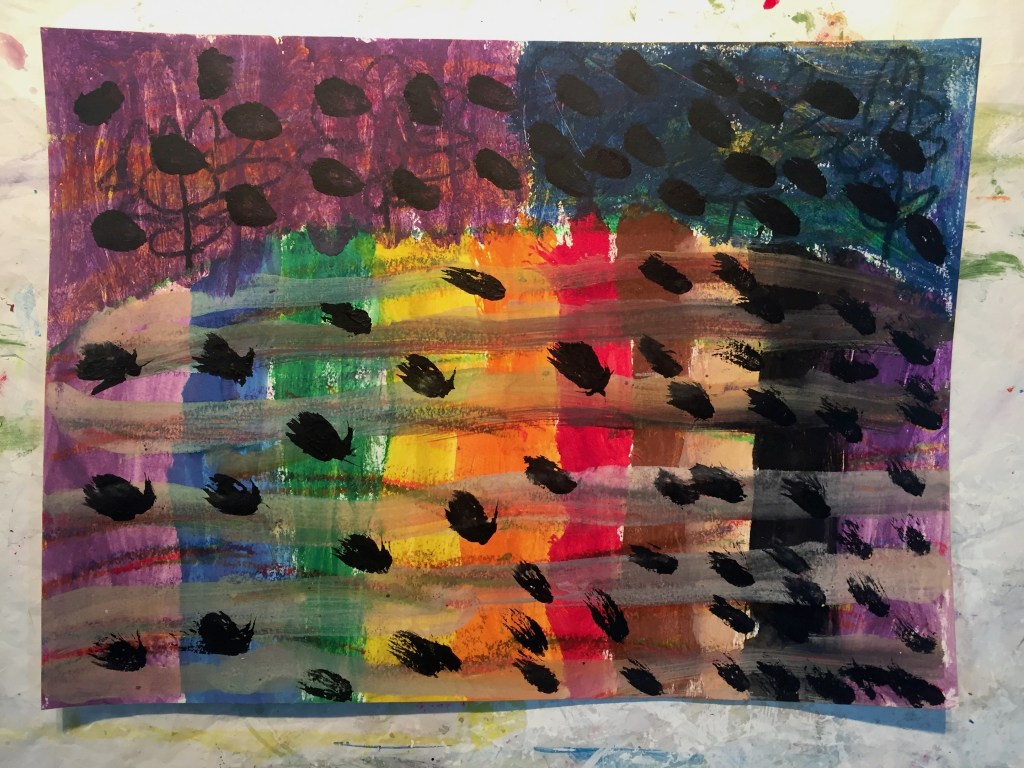
In the Studio Classroom Program, the classroom itself moves from school to museum for a week of intensive arts experiences and immersion in the museum environment, mixed with instruction of traditional subjects in the afternoon. The advantages to this immersion in an alternative setting are many:
- Students observe hundreds of artworks during their program in addition to the four works we discuss at length as we travel throughout the museum. Observations and questions are encouraged, helping students make connections to prior knowledge and personal experiences, as well as reinforcing new learning.
- Students become well-acquainted with their new, large “classroom” as they meet staff from all departments of the Museum including security, development, operations, curatorial and education. This results in a real-world understanding of what museums do and how they work.
- Students are empowered as they observe the relationship between what they see in Museum exhibitions and what they can make, reinforcing the notion that everyone can be creative in a variety of ways.
- Students who struggle with direct learning in the classroom feel valued and engaged when they can gain and share knowledge from peer discussions, sketching, and using their imagination to create artwork.
- Students make connections between what they are learning in the Studio Classroom and their traditional curriculum in ELA, science, math, foreign language, creative writing, geography, and history.
- Teachers gain knowledge about their students as they see them engage in new methods of observation, discussion, and creation.
- Students who feel comfortable in this alternative setting enjoy sharing their thoughts, ideas, and knowledge with family members, encouraging the increased participation of our community in engagement with our Museum and with visual art in general.
The classroom is set up to reflect the hybrid of both visual arts learning and traditional curriculum with space set aside for art supplies, posters that explain and illustrate art vocabulary like line, color, shape, texture, etc., and Museum Rules/Studio Rules, as well as dry-erase boards, projector, and screen. Students typically work on individual projects but are seated in groups of four to six per table.
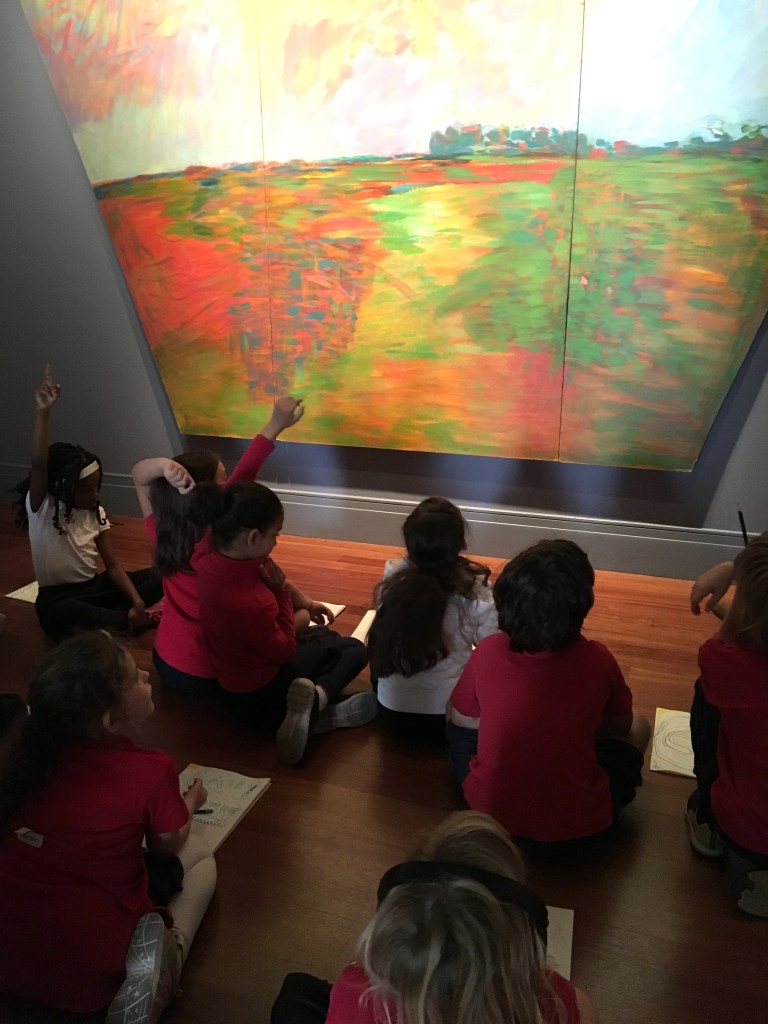
This framework is also easily adaptable because it can be implemented no matter what is on view in the museum, no matter what supplies are easily available for projects, and no matter the age of the students. It is loosely adapted from Harvard Graduate School of Education’s Project Zero initiative Studio Habits of Mind:
- Observation/Discussion Each day begins with careful observation and group discussion using Visual Thinking Strategies, leading the group on an exploration of the work and reaching a common understanding. VTS discussion encourages critical and flexible thinking, discovering meaning in visual objects, and appreciation of art history. We also discuss the elements of art during this time, including line, shape, color, texture, mood, space, and value. This block usually takes about 15 minutes per work observed, and we sometimes investigate up to three works of art per day.
- Sketching An important part of observing images in Studio Classroom also involves sketching in the Museum. Not only do the students’ sketches contribute to a greater understanding of the artworks, but they also serve as reference and inspiration for our art project of the day. I create “sketchbooks” for each student from six sheets of 18” x 24” sulphite drawing paper cut in half and stapled Each sketchbook usually lasts a student all week and is useful for “break time” free drawing and recording thoughts. his block usually takes about 10 – 15 minutes.
- Demonstration All students focus on looking and listening as I demonstrate the technique and order of the steps they need to remember to create their own piece. Students are encouraged to ask questions and suggest alternatives at the conclusion. This block usually takes about 10 – 15 minutes.
- Creation Working individually, students create their own piece using the given technique and supplies, using sketches and memories of works observed as inspiration. This is our largest block and takes up to 2 hours per day.
- Reflection After finishing their pieces, students are encouraged to share their artworks with the class and to examine their own use of the elements of art. I also ask them to think about what they did well, and what they would do differently if they could do the project over. We also recall our “Studio Rule” of making sure we say only kind and/or helpful things about each other’s work. This block usually takes about 10 minutes.
- Presentation If space is available at the Museum, we try to organize an exhibition to showcase student artwork. Apart from being a great opportunity to celebrate student achievement, these events bring new visitors into the Museum and encourage active participation in student learning.
Example Curriculum
Day 1: Landscapes
While observing Elemore Morgan’s View from the Prairie we explored the concept of a landscape, using vocabulary including line, color, shape, and texture, noting horizon lines, weather, plant life/environment, time of day, season, and mood, and whether the painting was abstract or realistic, or both. Students sketched their own landscapes, then in the studio, I demonstrated how to outline the landscape and set up the composition using oil pastel, and add large areas of color using watery tempera paint. We discussed the scientific concept behind an oil-water resist and then students made their own mixed-media landscapes.
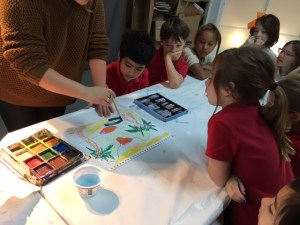
Day 2: Portraits
We studied Benny Andrews’ fabric collage Grandmother’s Dinner to discover portraiture and how artists depict people and the basic geometric shapes of the face. We talked about line, color, shape, texture, form, dimension, medium, and repurposing. I demonstrated how to cut shapes out of fabric and collage onto a background of scrapbook paper, and then students created their own portraits incorporating fabric, paper, and found objects.
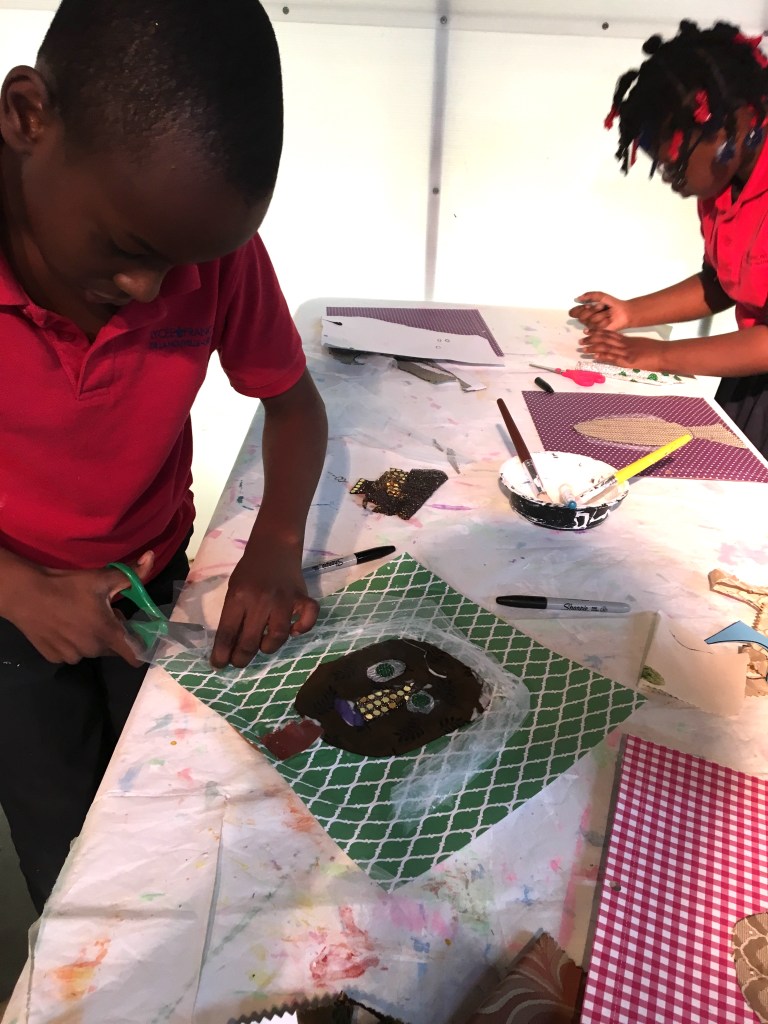
Day 3: Abstracts
During our discussion of Kendall Shaw’s massive geometric abstraction, Sunship (for John Coltrane), we focused on how the artist used line, color, shape, texture, and pattern to communicate a feeling that we all interpret differently. I demonstrated how to make patterns using acrylic paint, students made four different abstract paintings using repeated shapes and then stacked them together to form multilayered works.
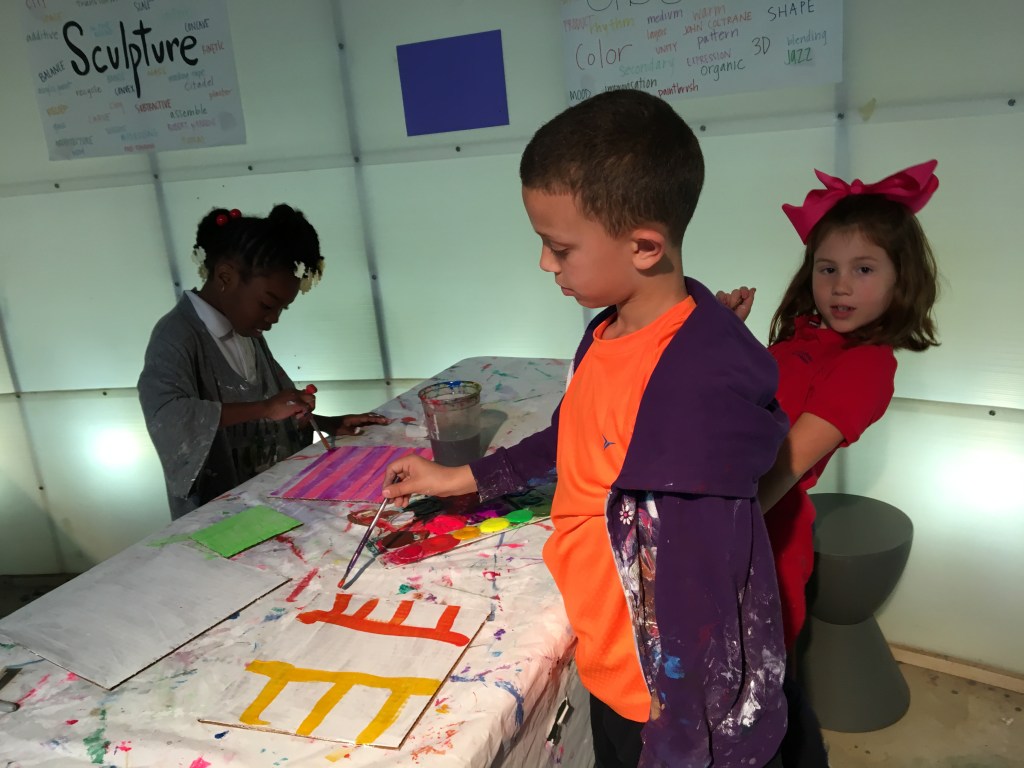
Day 4: Sculpture I
We examined the sculpture The Citadel by Robert Warrens and discussed the artist’s use of line, color, shape, form, texture, and medium. We talked about all the shapes we observed in the buildings: the walls, roofs, windows, doors, stairs, chimneys, and plants, then students drew their own architectural sketches. I demonstrated how to construct a building using four cardboard walls of the same size with masking tape to hold them together. Students constructed their own styles of roofs, staircases, waterslides, helicopter landing pads, balconies, swimming pools, and even people using a variety of cardboard and recycled materials. I painted the sculptures white to serve as a base coat for acrylic color and detail the next day.
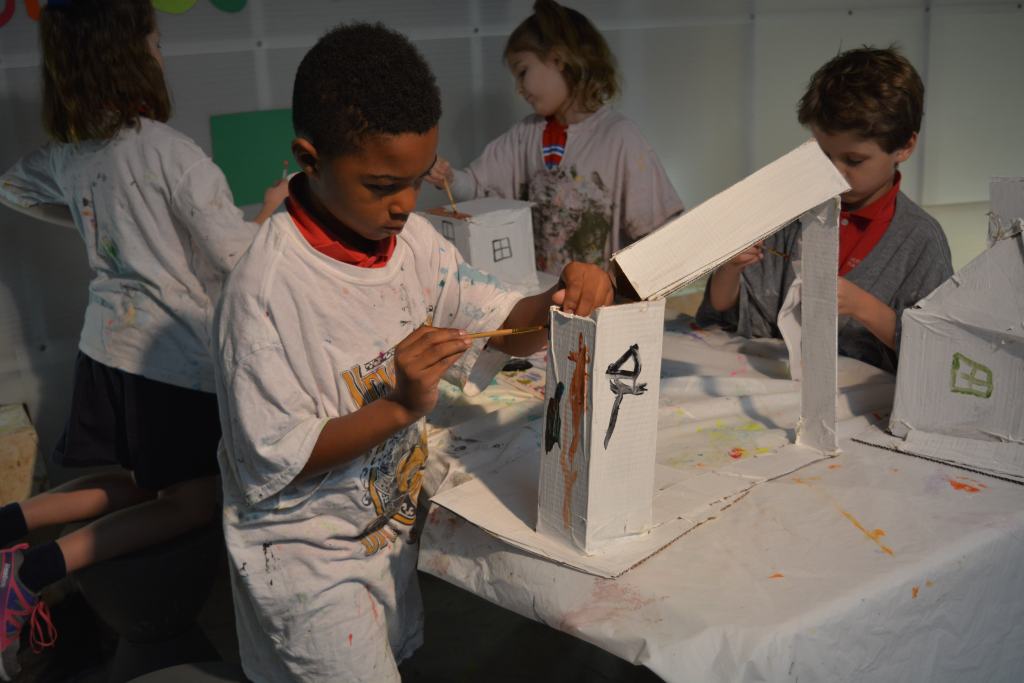
Day 5: Catch Up, Sculpture II
On our final day, we do not observe any new works or start any new projects, but students have free time to complete works from earlier in the week. I also demonstrate how to use acrylic paint to add detail to the cardboard houses, including the differences between flat and round paint brushes and how to wash paintbrushes. After completing all their projects, students engage in a written reflection in their sketchbooks focusing on what they learned from their week in the Studio Classroom, the best part of the program, and suggestions for changes.
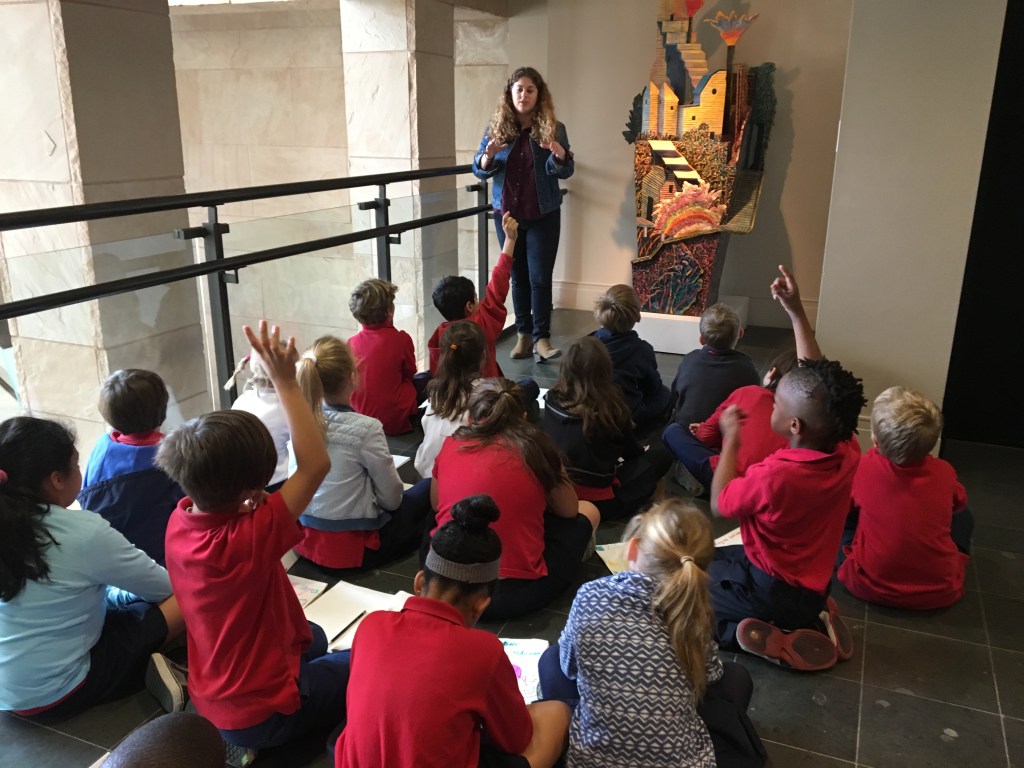
Presentation
If space is available, we organize an exhibition of student artwork. Students select their best work after a portfolio review where we look at everything they have created during the week. Students also create a museum label for their selected piece, reinforcing their understanding of artist, title, and medium. Students invite their families to an exhibition opening where they can demonstrate their knowledge of the works on view in the Museum as well as those they have created.
Frequently Asked Questions
Who can participate?
Any one class of students (up to 24 students) in any grade.
Where does the program take place?
In the Circle Gallery of the Ogden Museum, our multipurpose activity, and exhibition space.
How much does the program cost?
The Museum charges schools for instruction, supplies, and facility rental.
How do schools pay for the program?
Most schools pay for the program through a mix of grant applications and general operating funds.
How many staff members does it take to implement this program?
- Curriculum Coordinator Suzanna Ritz creates the lesson plans, schedule, and teaches from 9 am – 12 pm.
- Classroom Teacher (from the school) assists with classroom management and 1 pm – 3 pm instruction in regular curriculum.
- Classroom Assistant (from the school) assists with classroom management and documentation from 9 am – 3 pm.
- Education Manager Ellen Balkin assists with school communication, scheduling, and budgetary requirements.
What educational standards does this program address?
- Some Common Core Standards addressed in this program include building on others’ talk in conversations, responding to the comments of others and linking comments together, describing visual images with words, drawing conclusions from visual evidence, sequencing ideas logically, modifying one’s own views in light of new information, evaluating the soundness of reasoning and relevancy, and explaining own ideas and understanding.
- Some National Core Arts Standards addressed in this program include perceiving and analyzing artistic work, applying criteria to evaluate artistic work, using a variety of art-making tools, exploring uses of materials and tools, sharing materials with others, demonstrating safe and proper procedures for using tools, materials, and equipment, and sharing and talking about personal artwork.
How is the program assessed and evaluated?
- Studio Classroom Instructor assesses individual students based on their ability to observe, discuss, sketch, apply demonstrated techniques, use tools safely and properly, abide by Museum rules, and reflect on their own artwork.
- Evaluations are collected from classroom teachers, students, school administrators, and parents
How can I get more information about the Ogden Museum of Southern Art and/or the Studio Classroom Program?
Email Ellen Balkin, Education Manager, Suzanna Ritz, Curriculum Coordinator, or visit the museum’s website.
About the Authors
Ellen Balkin, Education Manager
Ellen first began her association with the Ogden Museum of Southern Art in Fall 2004. Since then she has held numerous positions in the Education Department, including Outreach Coordinator and Program Director of the Ogden Museum’s summer camps. From 2007 to 2009, Ellen also held the position of Education Coordinator for the Hermann-Grima Gallier Historic Houses. In 2011, she became the Ogden Museum’s Education Coordinator, assuming the position of Education Manager in June 2015. Since holding that position, the Museum has received the National Arts and Humanities Youth Program Award and was named the Outstanding Community Partner by the Orleans Public School Network. Ellen was most recently named the National Art Education Association’s Southeast Region Museum Art Educator. She holds a B.F.A. from Washington University in St. Louis. Contact Ellen at 504-539-9608.
Suzanna Ritz, Curriculum Coordinator
Suzanna is an artist and museum educator who lives and works in New Orleans. In her position as Curriculum Coordinator at the Ogden Museum, she helps guide visitors of all ages to discover the Museum’s collection and exhibitions, develops customized art experiences for tour groups and educators, helps implement Museum programs, including the Teen Docent Program, and teaches in summer camps and Museum residencies. Originally from North Carolina, Suzanna has a BA in Art History from Salem College and has studied Arts Administration at the University of New Orleans. Contact Suzanna at 504-539-9632.
Brought to you by Sage Xaxua Morgan-Hubbard, the American Alliance of Museums’ Ford W. Bell Fellow for Museums and P-12 Education.
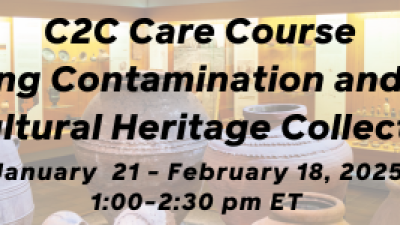



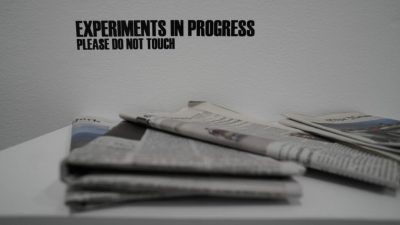

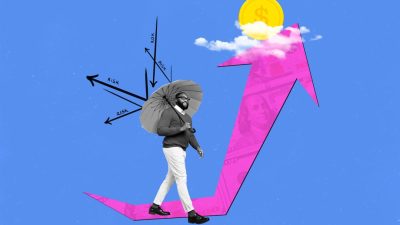

Dear Ellen and Susanna,
Thanks for this interesting post. You might find my dissertation interesting. My research findings mesh very well with many of the points made in this post, but also diverge in a number of ways, mainly because the museum-school partnerships that I was studying worked / work together in a very different way. You can find my dissertation here: https://pure.au.dk/portal/files/85300766/PhD_Interface_Learning_New_goals_for_museum_and_upper_secondary_school_collaboration.pdf
If you think any of your colleagues or people in your networks would be interested in reading my dissertation, please feel free to share. I would definitely appreciate it if you would let me know where and with whom you share. Many thanks in advance. You might also like to check out intrface.dk – there is an intro to the association in English. intrface is a national association of upper secondary schools and museums in Denmark.